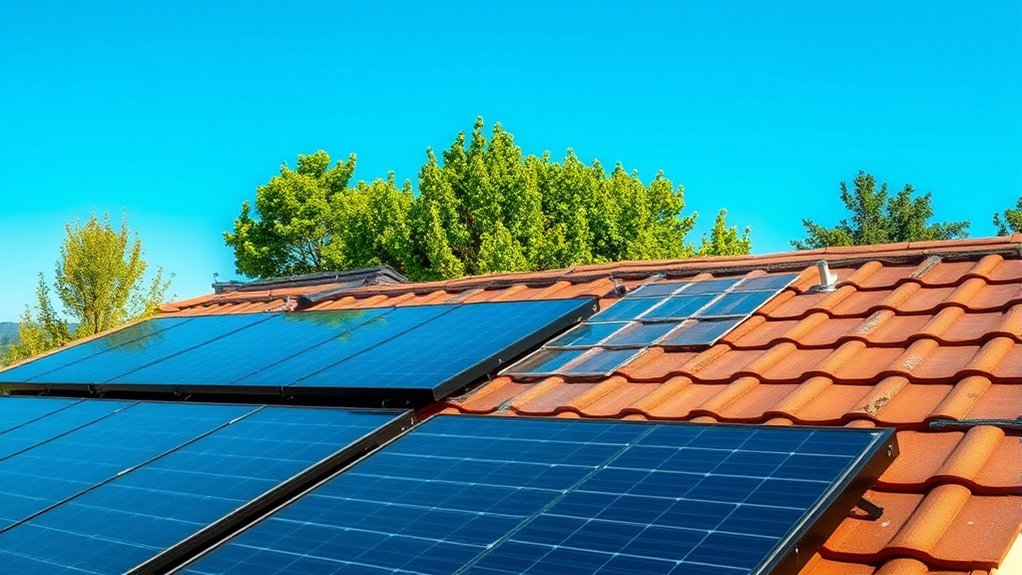If you’re choosing between solar panels and solar tiles, consider your priorities for cost, aesthetics, and efficiency. Solar panels are cheaper, easier to install, and offer higher energy output, making them ideal if you want quick savings. Solar tiles provide a seamless look and can replace roofing materials but come with higher upfront costs and slightly lower efficiency. To find out which option suits your home best and gets you the most value, explore the details further.
Key Takeaways
- Solar panels are more cost-effective and easier to install, while solar tiles offer a seamless, integrated aesthetic.
- Higher efficiency panels generate more energy in less space, reducing the need for larger installations compared to solar tiles.
- Solar tiles combine roofing and solar functions, potentially lowering roofing replacement costs but involve higher upfront expenses.
- Solar panels have a proven lifespan of 20-25 years, with easier maintenance; solar tiles’ long-term durability is still being evaluated.
- Both options qualify for incentives like the US Investment Tax Credit, but long-term savings depend on energy output and installation costs.

Renewable energy at home is becoming an accessible way to reduce your carbon footprint and lower energy costs. When considering how to harness solar power, you’ll find two main options: traditional solar panels and solar tiles. Understanding their differences helps you choose what best fits your needs, budget, and style. Solar panels typically achieve efficiency levels between 17% and 24%, allowing them to generate more electricity from a given area. This means you can produce significant energy with less roof space, which is especially helpful if you have limited roof area or want to maximize output. Leading solar panel models are highly efficient, enabling quicker returns on your investment by producing more power over their lifespan. In comparison, solar tiles usually have lower efficiency, averaging from 10% to about 20%, with most around 14%-18%. However, some advanced models, like certain CIGS types, are closing this gap, claiming efficiencies up to 22.8%. While solar tiles produce less energy overall, they can be more suitable if you’re seeking a seamless, integrated look, as they function both as roofing material and energy source. Keep in mind, though, that solar tiles often require larger installations to meet the same energy needs because of their lower efficiency, which can impact your overall cost and roof space.
Speaking of costs, solar panels generally come with a lower upfront price and installation fee, often two to three times cheaper than solar tiles for similar energy output. The higher initial cost of tiles relates to their materials and the more complex installation process, which demands precise measurements and specialized labor. If you’re replacing your roof or planning a new build, solar tiles can sometimes be cost-effective since they combine roofing and solar functions, potentially saving on separate roofing costs. Both options qualify for federal tax incentives, like the US Investment Tax Credit (ITC), helping offset initial expenses. Your long-term savings depend on how well your system produces energy, its durability, and how it integrates with your roof investment. Additionally, solar panels are often easier to maintain and repair, which can contribute to lower ongoing costs over their lifespan. The technological advancements in solar panel design continue to improve their efficiency and durability, making them a reliable choice for many homeowners. Installing solar panels is typically quicker and easier because most installers are familiar with standard setups. They can be installed faster, with fewer disruptions, and replaced individually if damaged. Solar tiles, however, require careful planning and precise fitting, especially during retrofits, which can be more disruptive and may need structural modifications. While solar tiles offer a sleek, integrated aesthetic that blends seamlessly with the roof, solar panels tend to be more conspicuous, potentially altering your roof’s appearance. Solar tiles may boost your property’s value, particularly if aesthetics matter, but they aren’t yet as proven in long-term durability as panels. Solar panels boast a proven lifespan of 20-25 years with established durability across different climates, while solar tiles, being newer, often come with warranties of around 20 years but lack extensive long-term data. Some manufacturers claim their tiles are as durable as the home itself and weather-resistant, but more real-world testing will clarify their longevity over time.
Frequently Asked Questions
What Is the Lifespan Difference Between Solar Panels and Solar Tiles?
You’re wondering about the lifespan difference between solar panels and solar tiles. Solar panels usually last 20-25 years, with some reaching up to 30-40 years, thanks to proven durability. Solar tiles generally have a shorter lifespan of 15-30 years, depending on the brand and technology. While both degrade over time, panels tend to have a longer, more predictable lifespan based on established performance warranties.
How Do Maintenance Costs Compare for Solar Panels and Solar Tiles?
Think of maintenance costs as the silent partner in your solar journey. You’ll find solar panels generally cost less to maintain—easy cleaning, simple inspections, and quick repairs. Solar tiles, however, demand more frequent upkeep, professional inspections, and can be costly to repair due to their integrated roofing role. While both require care, expect solar tiles to challenge your budget more over time, especially in harsh climates.
Can Solar Tiles Be Installed on Any Roof Type?
You’re wondering if solar tiles can be installed on any roof type. While they work well with materials like clay, concrete, or slate, some roofs, such as metal or asphalt shingles, are also compatible. However, fragile or brittle surfaces like slate require careful handling. You should evaluate your roof’s material, condition, and angle, and consult a professional to guarantee proper installation and peak performance.
Are There Any Aesthetic Restrictions for Installing Solar Tiles?
You might face aesthetic restrictions when installing solar tiles, especially in historic or architecturally sensitive neighborhoods. City councils and design boards often require approval to verify your roof remains visually compatible with its surroundings. These regulations aim to preserve neighborhood character, so you’ll need to check local rules and possibly seek permits. In some areas, approval is easier if the solar tiles seamlessly blend with traditional roofing materials, minimizing visual impact.
How Do the Warranties of Solar Panels and Solar Tiles Differ?
Oh, warranties—because who doesn’t love a good mystery? You’ll find solar panels usually come with 10-25 years for materials and 25-30 for performance, while solar tiles typically offer a flat 25-year warranty. Panels might last longer, but tiles often cover weather damage better. Some, like Solar Insure, offer 30-year plans, giving you peace of mind. Just watch out for transfer fees or hidden costs—they’re the real surprise!
Conclusion
As you weigh your options, remember that solar panels and solar tiles each offer unique benefits. Solar solutions spark sustainability, shine with savings, and sculpt your space into a sanctuary of self-sufficiency. Whether you choose the classic clarity of panels or the sleek sophistication of tiles, you’re shaping a greener future with every glowing gust of sunlight. Make your move today, and transform your home into a shining symbol of sustainability and solar serenity.









